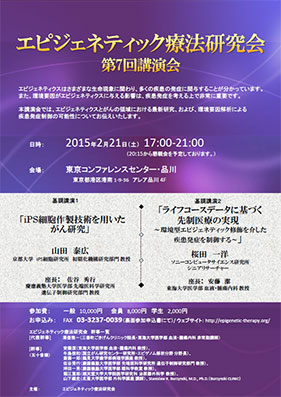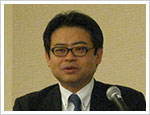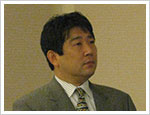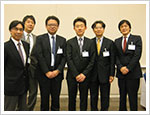第7回講演会

- 日程
- 2015年2月21日(土)
- 会場
- 東京コンファレンスセンター・品川
- 来場者数
- 58名
- 講演内容
-
-
基調講演1
「iPS細胞作製技術を用いたがん研究」
山田 泰広 (京都大学iPS細胞研究所 初期化機構研究部門 幹細胞腫瘍学分野 教授) -

人工多能性幹細胞(iPS細胞)の樹立には、遺伝子配列の変化は必要としない一方で、DNAメチル化などのエピジェネティック修飾状態がダイナミックに変化することが知られる。我々はiPS細胞作製技術を、エピゲノム状態を積極的に改変するツールとしてとらえ、がん研究への応用を試みている。本発表では、がん細胞からiPS細胞を作製する取り組みを紹介し、その過程から明らかとなりつつあるがん細胞の特徴について述べる。さらにがん細胞由来iPS細胞の再分化モデルを示し、遺伝子配列異常とエピゲノム制御に関連した細胞分化との接点を考察する。同時に、生体内細胞初期化による腫瘍発生モデルを紹介し、幹細胞性獲得と小児芽腫発生の関連について議論する。iPS細胞作製技術により明らかとなりつつある、がん細胞におけるエピゲノム制御について紹介したい。
-
基調講演2
「ライフコースデータに基づく先制医療の実現 ~環境型エピジェネティック修飾を介した疾患発症を制御する~」
桜田 一洋 (ソニーコンピュータサイエンス研究所 シニアリサーチャー) -

先制医療は一人ひとりのライフコースデータに基づき推論を行い、リアルタイムで選択支援を行うサービスによって実現する。このようなシステムを構成するデバイスをアンビエントエレクトロニクスと呼ぶ。MEMS(Micro Electro Mechanical Systems)技術の発達により、極めて小さなセンサーが開発され、それを搭載したアンビエントエレクトロニクスによってライフコースデータの取得は容易になってきた。これに対してライフコースデータの分析法を開発するには、遺伝要因と環境要因から推論を行う従来の生命科学枠組みを、状態の概念とコンテクストによって変化を表現できるものに変更しなければならない。この枠組みによって近年進歩が著しい深層学習やベイズ推定などの人工知能の技術を応用して生命現象の予測解析が可能になる。
参考文献:実験医学2015年4月増刊号「先生医療へ向かう医学研究」第3章 6データ主導型研究による先制医療の実現
-
研究発表
「Explorative study for phenylbutyrate sensitivity identified DNA methylation genes as biomarker candidates in human cancer
~ヒト癌におけるフェニルブチレート感受性に関する探索的研究により同定したバイオマーカー候補としてのDNAメチル化遺伝子~」
山下 継史 (北里大学医学部 外科学講座 講師) -

Phenylbutyrate (PB) は尿素サイクル異常症による高アンモニア血症患者に使用されている薬剤であり小児での安全性は確立されている。PBがHDAC阻害作用を有し抗癌活性を有することは基礎実験で確認され、脳腫瘍・黒色腫・白血病・結腸癌・前立腺癌などで実際に臨床効果が報告されている。現在我が国においては癌患者へのPB投与は保険診療として行うことができない。当研究会ではPBの臨床経験につき報告し、有効であった症例も経験している。今回、癌細胞に対しての PBの感受性を調べ、感受性に関わる分子機序を探索した。乳癌細胞株においてPB感受性株・抵抗性株を同定しマイクロアレイを用いて包括的遺伝子発現解析を行った。抵抗性遺伝子 (ANKD1, Ets1, KIAA1199, IFI16, PTRF/cavin-1)・感受性遺伝子 (Rab25, ESRP1) 候補遺伝子は epigeneticに制御されていることが明らかになった。遺伝子導入による実験から、Rab25, ESRP1遺伝子が実際に PBの感受性に関わることが示され、その上流遺伝子 Zeb1を同定した。Zeb1はさらに MiR200等で epigenetic に制御されている。現在、乳癌における Zeb1発現と薬剤感受性についての研究を開始した。
-
症例紹介
「フェニルブチレートの臨床経験」
澤登 雅一 (三番町ごきげんクリニック 院長) -
新たなフェニルブチレート有効症例を経験したので報告する。
症例)64歳 女性 卵巣癌。
経過)09年10月29日、卵巣庵の診断で、両側付属器摘出術・単純子宮全摘出術・骨盤内リンパ節郭清術施行。病理学的には、混合型(移行上皮癌・類内膜腺癌)、低分化型で卵巣壁外浸潤なく、T1aN0M0の診断。術後補助治療として、09年11月~PTX+CDDPを3コース施行。
10年10月のCTで、左内腸骨リンパ節転移を認めたため、10年10月~13年6月にかけて、DTX+CPT-11、GEM、ADM単独などの化学療法を施行したが、13年6月のCTにて、多発肝転移、骨盤内に病変による水腎症、直腸(S状結腸)浸潤みられたため、標準治療無効との判断となり治療を中止、緩和ケア科をすすめられた。
13年7月より、フェニルブチレート6g/日内服開始。当初、食思不振・腹痛・下血などの腹部症状が強く内服できない、もしくは1g/日しか内服できない期間があった。また、腎盂腎炎を繰り返し、貧血の進行(Hb 6.4)もみられたが、しっかりと3g/日内服可能になった14年3月頃より、発熱は少なくなり、14年6月頃より、腹部症状もほとんど消失、貧血症状もなくなった(Hbは 11.3まで回復)。15年2月の時点で、全身状態はすっかり改善している。
- パネルディスカッション
-

講演と発表のあとにすべての演者によるパネルディスカッションが行われました。
会場の参加者の方からの質問も議論に盛り込まれ、活発なディスカッションとなりました。
- 懇親会
-



-
The 7th symposium
- Speech
-
-
Special Lecture 1
“Cancer Research with iPS Cell Technology”
Yasuhiro Yamada (M.D., Ph.D., Professor, Department of Reprogramming Science, Center for iPS Cell Research and Application (CiRA), Institute for Integrated Cell-Material Science (WPI-iCeMS), Kyoto University)
Chairman: Hideyuki Saya (Professor, Division of Gene Regulation, Institute for Advanced Medical Research, Keio University Graduate School of Medicine)
-

It is now generally recognized that genomic sequence alterations are not required for establishing induced pluripotent stem cells (iPS cells), while epigenetic modifications, as exemplified by DNA methylation, undergo dynamic changes. We have been attempting application of iPS cell technology to cancer research by using it as a tool for actively modifying the epigenomic state. This presentation briefly reviews the ongoing activities intended to reprogram cancer cells, and deals with the characteristic features of the reprogrammed cancer cells. Furthermore, we shall present a cancer cell-derived iPS cell redifferentiation model and discuss the association between the genomic sequence abnormality and epigenetic regulations related to cellular differentiation. Finally, we shall introduce a tumorigenesis model based on cellular reprogramming in vivo, and discuss the relation of acquisition of stemness to the development of blastomas. We would like to introduce epigenetic regulation in cancer cells, which has been uncovered by utilizing the iPS cell technology.
-
Special Lecture 2
“Realization of Preemptive Medicine by Life Course Data
~ Control of Disease Development via Environmental Epigenetic Modifications ~”
Kazuhiro Sakurada (Senior Researcher, Sony Computer Science Laboratories, Inc. Chairman: Kiyoshi Ando, Professor, Department of Hematology and Oncology, Tokai University School of Medicine)
-

Preemptive medicine will be realized through providing decision support in real time by using inference based on individualized life course data. The devices constituting such a system are termed ambient electronics. With the recent advances in Micro Electro Mechanical Systems (MEMS) technologies, ultra-small sensors have been developed, making it easier to acquire life course data via the use of ambient electronic devices with built-in ultra-small sensors. In order to develop methods for life course data analysis, on the other hand, it is imperative to alter the conventional framework of life science involving inference from genetic factors and environmental factors into a framework which enables representation of changes via the concept of state and context. With this framework, it will become feasible to carry out predictive analysis of vital phenomena through application of deep learning and artificial intelligence technologies, e.g., Bayesian estimation, a field in which remarkable progress has been made in recent years.
Reference: Chapter 3. Section 6. Realization of preemptive medicine by data-driven research. In: Experimental Medicine (Jikken-Igaku), Vol. 33-No. 7, 176-183, April 2015. -
Research Presentation
“Explorative study for phenylbutyrate sensitivity identified DNA methylation genes as biomarker candidates in human cancer”
Keishi Yamashita (Lecturer, Department of Surgery, School of Medicine, Kitasato University)
Chairman: Kiyoshi Ando (Professor, Department of Hematology and Oncology, Tokai University School of Medicine)
-

Phenylbutyrate (PB) is currently prescribed for patients with hyperammonaemia due to urea cycle disorders and its safety in pediatric patients has been established. Basic laboratory studies have demonstrated that PB is endowed with a Histone Deacetylase (HDAC)-inhibitory effect and has antineoplastic activity. Efficacy of PB in patients with tumors such as brain tumor, melanoma, leukemia, cancer of the colon and cancer of the prostate has been reported. However, at present, administration of PB to cancer patients is not covered by the national health insurance system in Japan. Our study group has previously reported our clinical experience with the use of PB in cancer patients, which includes reports of cases where the drug was effective. This study was undertaken to investigate the sensitivity to PB of cancer cells and explore the molecular mechanisms underlying such sensitivity. Among breast cancer cell lines, PB-sensitive cell lines and PB-resistant cell lines were identified and subjected to comprehensive gene expression analysis using microarrays. The analysis revealed that the candidate resistance genes (ANKD1, Ets1, KIAA1199, IFI16, and PTRF/cavin-1) and candidate sensitivity genes (Rab25 and ESRP1) were under epigenetic control. Experiments employing gene transfer disclosed involvement of the Rab25 and ESRP1 genes in the sensitivity to PB, and their upstream gene (Zeb1) was identified. Zeb1 was noted to be further controlled epigenetically by MiR200 and others. A study on Zeb1 expression and drug sensitivity in breast cancer has been initiated.
-
Case Report
“Clinical Experience with Phenylbutyrate”
Masakazu Sawanobori, Director, Sanbancho Gokigen Clinic
Chairman: Kiyoshi Ando, Professor, Department of Hematology and Oncology, Tokai University School of Medicine
-
In this report, we describe a case encountered recently by us, in which a gratifying response to phenylbutyrate therapy was achieved.
[Case] A 64-year-old woman with cancer of the ovary
[Course] The patient was treated by simple total hysterectomy combined with bilateral adnexectomy and pelvic lymphadenectomy for the diagnosis of cancer of the ovary on October 29, 2009. Histopathologically, the lesion was diagnosed as a mixed-type (transitional cell carcinoma and endometrioid adenocarcinoma), poorly differentiated T1aN0M0 tumor, without evidence of extramural invasion. Therefore, the patient was administered three cycles of PTX + CDDP chemotherapy as postoperative adjuvant treatment from November 2009.
A CT performed in October 2010 revealed metastasis to the left internal iliac lymph nodes, and the patient was given chemotherapy with such regimens as DTX + CPT-11, GEM alone, and ADM alone from October 2010 to June 2013. However, multiple hepatic metastases, hydronephrosis due to the intrapelvic lesions, and invasion into the rectum (sigmoid colon) were noted on the repeat computed tomography (CT) performed in June 2013. Therefore, standard treatments were concluded as being ineffective in this case, and palliative treatment was scheduled.
In July 2013, the patient was started on oral phenylbutyrate at the dose of 6 g/day. At first, the patient was unable to even take an oral dose or could barely take a 1-g dose daily, because of pronounced abdominal symptoms such as anorexia, abdominal pain and melena. She also had repeated episodes of pyelonephritis with progressive anemia (Hb: 6.4). From around March 2014 onwards, when the patient became capable of taking 3-g/day doses consistently, nevertheless, the fever resolved and the abdominal symptoms subsided almost completely, along with improvement of the anemia (Hb: recovered to 11.3). Her general condition had improved significantly as of February 2015. - Panel Discussion
-

Panel discussion among all the speakers was held after the speeches and presentations.
Questions from audiences were integrated into the discussion with the speakers.
-







